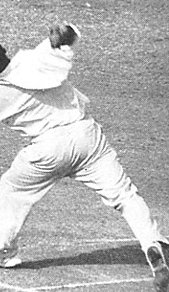
 |
| Index | ||||||
|
Throwing, Chucking  Throwing - occasionally called chucking - the sort sometimes done by bowlers when they are supposed to be bowling, is a subject in which emotions can run high. And it has been like that for a long time In 1851, after it had become clear that most professional umpires were unwilling to no-ball a bowler for throwing, MCC issued a statement calling on umpires in their matches to apply the Law Significantly, and just as true to-day as then, the statement acknowledges that 'it is impossible to define a throw'. The Laws of Cricket, though, have to have some sort of 'rule' that defines a throw in the context of the game of cricket and it does that with admirable simplicity. In essence it says that while the bowler's arm is in the delivery swing, it must not straighten from the time that it reaches shoulder level until the ball is delivered. There is the further condition that the straightening doesn't need to be complete. This means that if the arm starts off bent and ends up still bent but less so, then it has straightened 'partially', and that is not allowed You may have heard talk of bowlers' arms being allowed to straighten by a certain number of degrees (generally about 15, but sometimes less) without it being illegal. How can an umpire judge 15 degrees? Of course he cannot. That figure, and others that may be used, have been arrived at in discussions between those responsible for top level cricket and experts in biomechanics - 'how the body is able to move' to you and me. TV footage and specially taken, high speed videos are studied by experts, including former international bowlers and umpires plus experts in biomechanics and, inevitably perhaps, legal advisers Thankfully all this technology and expert advice does not replace the umpire on the field of play. He still makes his judgement according to the Laws of Cricket. If he is certain - suspicion is not enough - that the Law has been breached he will no-ball the bowler. After three such occasions the bowler is not allowed to bowl again in that innings In matches at the higher levels of the game, an umpire will report any suspicions he has about the legality of the bowler's action to the appropriate body - ICC, ECB for example - who will call in the experts to assess the action. This might lead to a bowler's action being deemed lawful, or it may result in his being suspended Whether suspended or simply warned, a bowler whose bowling action is not acceptable will be helped to modify it so as not to offend the Laws - a much more enlightened attitude than appears to have prevailed in former times when bowlers were often no-balled out of the game | ||||||